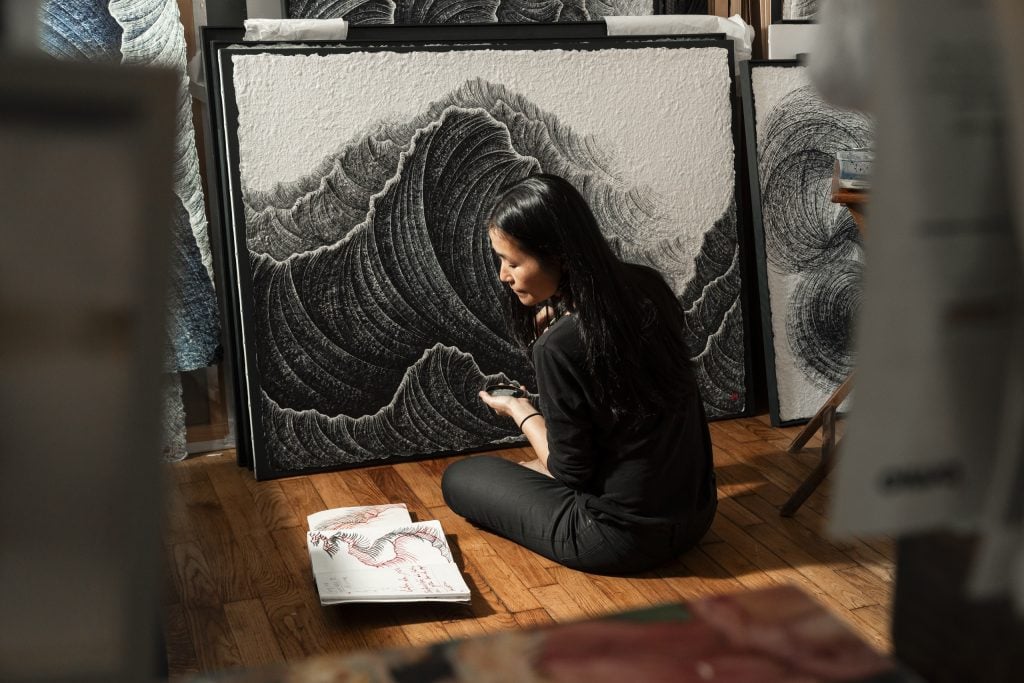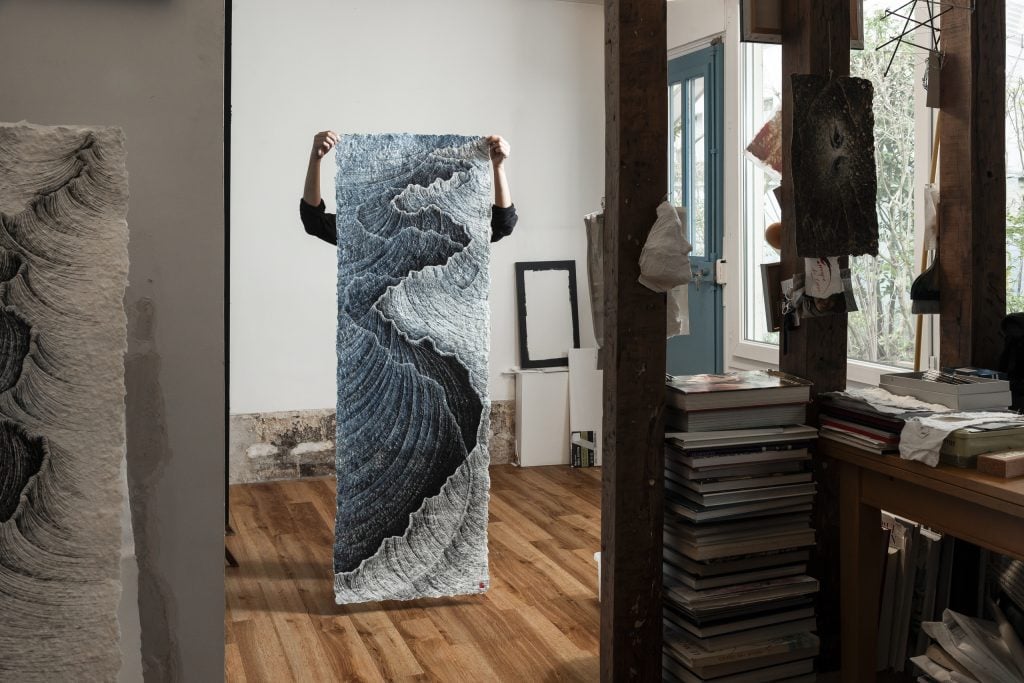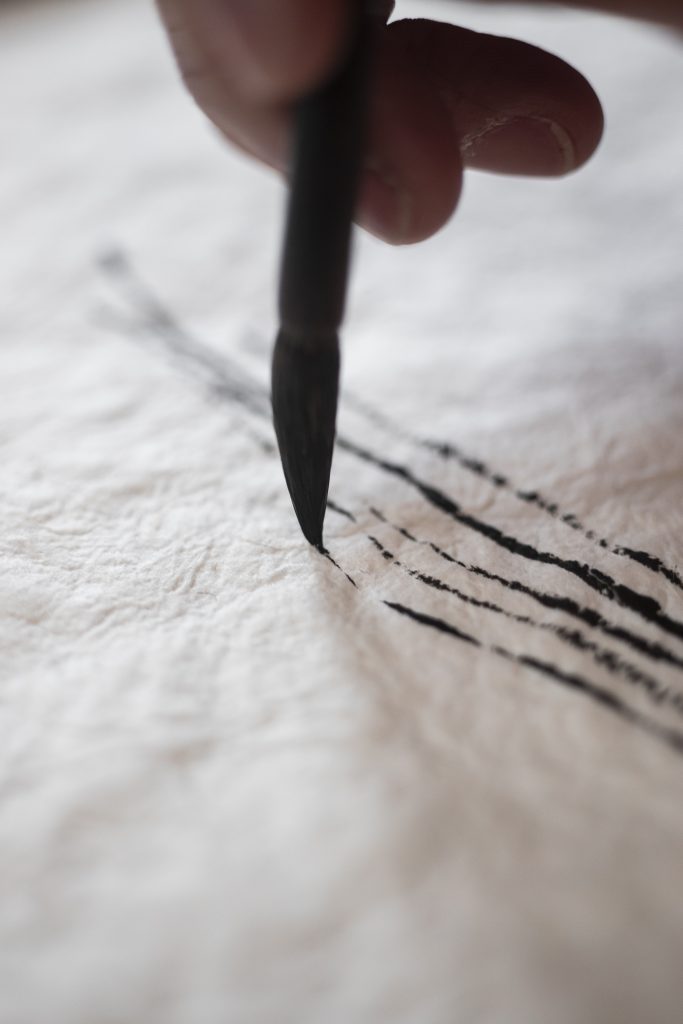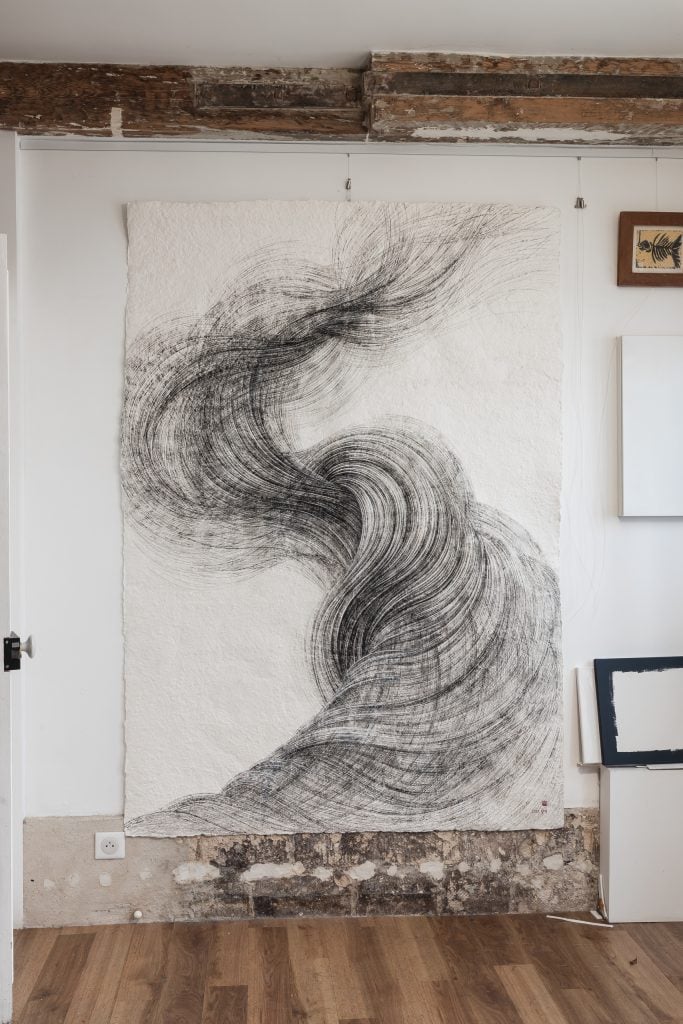Gallery Network
7 Questions for Artist Lee Hyun Joung on Mining Her Dual Heritage for Inspiration
The artist will be the subject of a solo show at Galerie Sept, Brussels, this April.

The artist will be the subject of a solo show at Galerie Sept, Brussels, this April.

Artnet Gallery Network

Originally from Seoul and currently based in Paris, artist Lee Hyun-Joung (b. 1972) is recognized for using traditional Korean pigments and Hanji paper in works that have a decidedly contemporary air. She studied fine arts at Sejong Univeristy in Seoul, and later trained in goldsmithing in Paris. That unique combination has contributed to her distinct artistic method that sees both French and Korean materials, methods, and techniques used and mined as sources of inspiration.
Lee was included in the inaugural exhibition of Galerie Sept’s location in the Belgian city of Knokke in 2022, and this April 4, 2024, a new solo show will open with the gallery in Brussels. Presenting a recent body of work, the show highlights her capacity for highly intricate and detailed composition, as well as ongoing thematic engagement with ideas and themes around memory, journeys, and the trajectory of life.
Recently, we reached out to Lee to learn more about her practice—both technically and thematically—as well as how working with Galerie Sept has influenced her.

Artist Lee Hyun Joung holding up an artwork inside their studio. Photo: Nick Verhaeghe. Courtesy of Galerie Sept, Brussels.
How would you describe your creative practice? Is it meticulous and planned out, or more organic and intuitive?
My creative process is fundamentally intuitive and organic. While I value the traditional techniques and principles I’ve been taught, my actual creation unfolds in the moment. The dance of the brush on Hanji paper, the flow of homemade ink—these elements guide me more than any preconceived plan. It’s a dialogue with the materials, where spontaneity and the physical gesture are paramount. Each piece evolves from intuitive actions, revealing the beauty of the creative journey.
The theme of journeys or pathways—physical, psychological, and spiritual—is recurring in much of your work. What does this stem from? And what do you hope viewers of your work take away with them?
This theme originates from my dual heritage and my life’s journey, straddling the rich traditions of South Korea and the expansive artistry of France. My works are metaphors for life’s journey, reflecting paths that are at once physical, psychological, and spiritual. Through my art, I hope viewers find a moment of contemplation, a space where they can embark on their own introspective journeys. Each piece is a heartfelt invitation to delve into personal reflection, inviting viewers to explore the landscapes of their souls and discover the depths of their own paths.

Artist Lee Hyun Joung. Photo: Nick Verhaeghe. Courtesy of Galerie Sept, Brussels.
From a technical standpoint, what does your practice look like? Where do you start?
I begin with the preparation of my materials—carving the Hanji paper from mulberry paste and creating my inks from natural pigments. The initial stage is crucial, as it sets the foundation for the entire creative process. My practice is deeply rooted in the physical interaction with these materials, working directly on the ground to apply the pigments in fine brushstrokes. The process is slow, deliberate, and responsive, allowing the characteristics of the paper and ink to guide the development of each piece. It’s a dance of creation that starts with the most basic elements and evolves into a complex narrative.
Where do you most commonly find inspiration?
My inspiration comes from the interplay between my Korean heritage and my life in France. The rich history of both cultures, their landscapes, philosophies, and artistic traditions, provide a continuous source of inspiration for me. Additionally, nature and its endless variations of textures, patterns, and forms play a significant role in my work. I’m also inspired by the human condition—the emotional and spiritual journeys we all undertake.

Detail of Lee Hyun Joung applying ink. Photo: Nick Verhaeghe. Courtesy of Galerie Sept, Brussels.
You’ve been collaborating with Galerie Sept since 2018. How has this relationship affected your practice?
Galerie Sept—and my gallerist, Florian Araïb since the early days—has been instrumental in my growth as an artist. The gallery’s unwavering support and belief in my vision have given me the freedom to explore and push the boundaries of my craft. This partnership has provided me with opportunities to showcase my work to a broader audience, allowing for fruitful exchanges and encounters that have enriched my practice. The gallery’s commitment to my artistic journey has been a source of encouragement, motivating me to continually evolve and refine my work.
Do you have any particularly memorable moments from your time working with the gallery?
The most memorable moment has been the preparation for my solo exhibition, “Ridge Lines.” It marks a significant milestone in my career and our collaboration. This exhibition encapsulates our shared journey, highlighting the evolution of my work over the past six years. The support and dedication of Galerie Sept in bringing this vision to life have been truly remarkable, making this event not just a showcase of my art but a celebration of our enduring partnership.

Artwork inside the studio of Lee Hyun Joung. Photo: Nick Verhaeghe. Courtesy of Galerie Sept, Brussels.
Can you tell us a bit about what you are working on now? Or hope to work on next?
Currently, I am exploring deeper into the themes of memory and the passage of time, how these concepts can be visually represented through the interaction of ink and paper. Looking ahead, I aim to continue challenging the boundaries between abstraction and figuration, further integrating my cultural heritage and contemporary influences. My goal is to keep expanding my visual and conceptual vocabulary, creating works that resonate on multiple levels and continue to invite viewers into a dialogue with the inner landscapes of their minds.
“Ridge Lines” opens at Galerie Sept April 4, 2024.